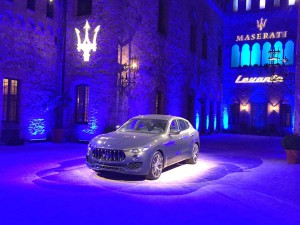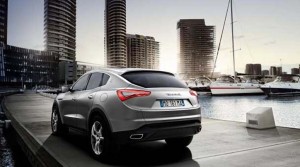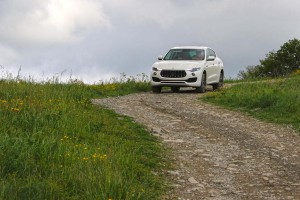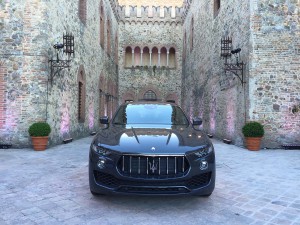Say the name, Maserati, and you’re likely to picture a sleek sports car like the Ghibli, perhaps, screaming down the Autostrada. But bouncing along a rutted and rock strewn path that was old by the time the Romans packed it in?
That’s where we’ve found ourselves on a drizzly weekday morning, a couple hours outside of Milan, wandering our way through a course set up to train Italian mercenaries and special forces. Not the sort of place you’d traditionally expect to find a Maserati. Then again, the Levante isn’t your typical Maserati. The 2017 model is the maker’s first sport-utility vehicle. And we had come to Italy to find out if that was a compatible combination or an automotive oxymoron.
Maserati has been toying around with the idea of adding an SUV to its line-up since 2003, when it showed off the original Kubang concept. The notion went nowhere until 2011, when a new prototype made its debut at the Frankfurt Motor Show. After taking a few unexpected detours, the rechristened Maserati Levante is about to start rolling into showrooms around the world.
(Big price, big goal for new Maserati Levante. Click Here for the story.)
The 2011 show car was originally intended to be an upscale version of the Jeep Grand Cherokee. Along the product development path, the project took an unexpected, albeit it fortuitous, detour. The decision was made to produce the Kubang/Levante in Italy, rather than the U.S., and that lent credence to the idea of basing the ute on a Maserati platform, rather than retooling a plant to produce a modified Jeep, explained product chief Roberto Corradi.
It helped that the Italian maker was in the midst of a product development burst, and it was able to tap into the Ghibli project, borrowing the basic platform and other key components from that new sports sedan. That said, a day behind the wheel of the 2017 Maserati Levante revealed it to be more than just a beefed up Ghibli.
The project also coincided with the development of the popular Maserati Alfieri, something immediately apparent as we did our initial walk-around. The Levante stands tall and proud, but it retains a bit of the classic grand turismo look, with the cats-eye LED lamps, shark nose and concave grille. Those details do more than give it a sporty appearance. Levante is surprisingly aerodynamic, with a drag best-in-class drag coefficient of 0.31. The fastback roofline, meanwhile, culls a little bit of the SUV’s mass.
And it is a big beast, weighing in at a base 4,649 pounds in U.S. trim – despite the extensive use of aluminum body panels — which includes Maserati’s Q4 all-wheel-drive system as standard gear. The system is rear biased and, under optimal conditions will send 100% of its torque to the back tires. Where there’s significant slip, as much as 50% will be redirected to the front wheels temporarily.
Power comes from a quarter of engines worldwide, including two diesel and two gasoline engines. For now, we’ll see just the latter two in the States, most notably the 424-horsepower twin-turbo 3.0-liter V-6. That’s enough to get you to 100 in an eye blink over 5 seconds, with a top speed of 164 mph. Making 528 pound feet of torque, the package also can handle a trailer of nearly 6,000 pounds.
(A detuned version of the twin-turbo six will cut you down to 356 hp, still enough to make 60 in 5.8 seconds and top out at 158 mph.)
There’s no low gear package – something abandoned when Maserati decided not to rebadge a Jeep Grand Cherokee. But the Levante proved surprisingly capable of handling trails that were far and away rougher than all but the most dedicated trail hound would consider.
(Luxury SUVs rule at the 2016 NY Auto Show. Click Here for the story.)
The challenge was to come up with a package that could also deliver Maserati-like handling and performance on-road, as well as off. A number of things helped the engineering team pull that off. To start with, the Levante gets a double-wishbone front, with a five-arm multilink rear. The adjustable air-suspension system can raise or lower the big ute by as much as 3.4 inches. Set it for maximum clearance on a trail and it will automatically lower itself when you head back out on the highway.
Both front and back, the SUV also uses the maker’s driver adjustable Skyhook shock damping system. And there’s an electrically assisted hydraulic steering system to give a driver a clear feel of the road.
Along with raising or lowering the body, the various settings alter shift points, steering response and even the exhaust note. In Sport mode, you’ll readily feel the steering and suspension tighten up, even as bypasses open up in the exhaust system to give full voice to the twin-turbo six.
(Debt rises, but Fiat Chrysler earnings exceed expectations. Click Here for the story.)
You’re not likely to hear that on an off-road excursion. Not until you’re back on the highway, that is. Shaking some of the mud out of the tires, we were ready to see if the Levante was a true Maserati once we passed through the tollbooth and headed out on the Autostrada. Sadly, there are plenty of speed cameras clocking one’s progress these days. But we still managed to nudge the big ute up and over the 200 kmh (125 mph) mark a few times.
Well over 200. And were it not for Levante’s “command seating” position we might have forgotten we were driving a nearly 2.5-ton SUV.
Those seats, incidentally, can be trimmed in silk from fashion house Zegna, if you opt for the luxury edition. Either way, you’ll get 12-way power seats and plenty of room to move around. One complaint was a slightly odd pedal position that tended to make our throttle foot ache a little after a few hours of driving. Only later were we advised that Maserati is offering power-adjustable pedals as an option.
Along with the Zegna silk, a buyer can opt for a wide range of leather, wood and carbon fiber interior trim options. The center console, meanwhile, is topped by an 8.4-inch navigation and infotainment screen. Some buyers might grumble that the display package is the one piece visibly lifted from the Jeep toolbox. It’s not quite up to the rest of the luxurious interior visually, but functionally, it’s a nice system.
In terms of technology, the 2017 Maserati Levante also features some of the latest digital safety systems, including adaptive cruise with forward collision warning and auto braking capable of stop-and-go operation in traffic. There’s also a 360-degree surround view camera with multiple view options. That’s useful both on the trail and in a parking lot.
The 2017 Maserati Levante S will be starting at $83,000 plus delivery fees, the detuned Levante at $72,000.
The Levante will be going up against an increasingly crowded field of luxury SUV competitors. In fact, it’s hard to find a high-line brand – from Jaguar to Bentley to Lamborghini – not getting into this space. Immediate competitors will include the likes of the Porsche Cayenne and BMW X5.
The distinctive design of the Maserati Levante is clearly polarizing, and not for everyone, but it is creating quite a bit of buzz. And that’s something the Italian automaker can use. Maserati has high hopes for the first SUV in its more than 100-year history. It’s hoping to sell at least 30,000 a year. That would make it the brand’s most popular model ever, accounting for nearly half of its total volume.
The Levante is clearly not for everyone. But it does offer the sort of ride, features and design that will connect, we believe, with enough buyers to keep the Maserati assembly line rolling.






